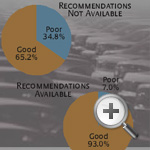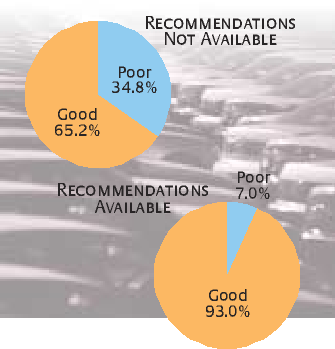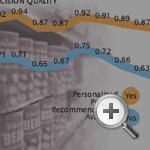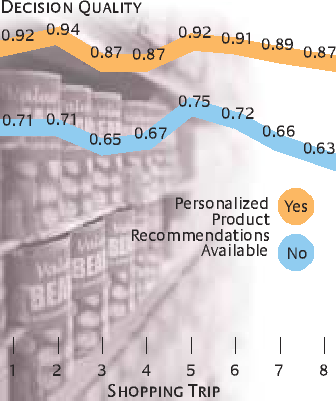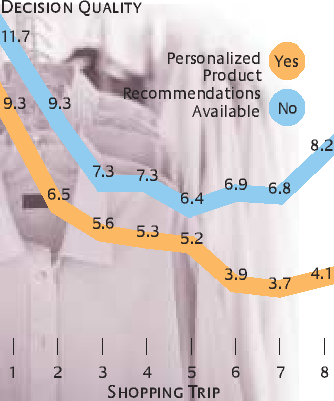Double Agents
INTELLIGENCE: RESEARCH BRIEF: Assessing the role of electronic product-recommendation systems.
Topics
Competing With Data & Analytics
Electronic information can easily overwhelm people with large volumes of data. An abundance of information often strains human limits: attention, memory, motivation or other factors. In response to this challenge, software that assists humans in filtering and organizing information into more digestible amounts and formats have appeared (Alba et al., 1997; Häubl and Trifts, 2000; Todd and Benbasat, 1999, 2000). Real-world examples of such electronic decision aids include ePocrates, which provides pharmacists with valuable summary information on drug interactions through a personal digital assistant and news Web sites that allow users to personalize the presentation of weather information. These decision aids are altruistic in the sense that they have no vested interest in what the user does with the information. Similar applications exist in many markets to help buyers make complex purchase decisions. For example, in Canada, MLS.ca screens houses for sale based on the buyer’s preferences for location, price, size and other features.
However, not all decision aids are altruistic. Indeed, many are designed not just to assist buyers but also to steer them in a particular direction. This makes them “double agents.” Over and above helping buyers make choices, they act on behalf of sellers to influence buyer behavior. Examples of such decision aids exist at a number of vendor sites including Amazon.com’s “Your Store,” GM’s “Auto Choice Advisor,” and IBM’s “Solution Profiler.”
This article focuses on electronic agents that provide online shoppers with personalized product recommendations and the benefits and potential difficulties consumers may experience when using such decision aids. An electronic recommendation agent is a decision aid that 1) helps the consumer understand his or her preference, in terms of product attributes, based on a learning phase during which the consumer reveals subjective preference information to the agent; and 2) makes personalized recommendations in the form of a sorted list of products based on its understanding of the consumer’s preference (Ariely et al., 2004; Häubl and Trifts, 2000).
The Benefits Of Agent-Assisted Shopping
Most of us have relied on the recommendation of a sales clerk in a department store, an auto mechanic or someone else who had a vested interest in what we buy. We realize that these people may be biased. Nevertheless, we think their input can be worthwhile. They can save us time and energy and help us to avoid problems. Similarly, consumers rely on electronic recommendation agents to help them make better decisions with less effort. The research we examine focuses on how electronic agents that provide personalized product recommendations affect the effort-accuracy tradeoff in decision making (Payne, et al, 1993; Todd and Benbasat, 1992, 1999) and demonstrates the considerable benefits recommendation agents can bring consumers.
Better Product Choices.
Häubl and Trifts (2000) conducted a large-scale consumer experiment to assess the benefits of using a recommendation agent to shop for a backpacking tent and a mini stereo system at an online store. (To motivate them to choose wisely, participants were informed that a few of them would actually receive one of the products they chose during their experimental shopping trips.) Consumers were randomly assigned to one of two experimental conditions: shopping with the help of an electronic recommendation agent and shopping without such assistance. The key dependent variables for comparing the two conditions were decision-making effort and decision quality. Information on preferences was obtained by asking participants to rate the importance they attached to each of six product attributes (on a 100-point scale). For consumers in the recommendation agent condition, the preference information was used to personalize the presentation of the available products. Products were listed in descending order of their anticipated attractiveness to the shopper, using a weighted additive preference model (Payne et al., 1993) based on his or her attribute importance ratings. For customers in the unassisted condition, the products were presented in random order. (See “About the Research.”).
The authors used two measures of decision quality. The first looked at the share of consumers who chose products that had been designed to be objectively superior to other available products. When recommendation agents were used, 93% of consumers selected one of these superior products, compared to about 65% without such assistance (see “The Agent Effect”). The second measure of decision quality was consumers’ propensities to reverse their original choices. After completing their shopping trips, subjects had an opportunity to switch from the product they had chosen initially to several attractive alternatives all of which had been available on the prior shopping trip. (Participants understood that, if they were among those selected to receive their chosen product along with a cash reward, they would get whatever product they selected after they had the opportunity to switch.) Switching was interpreted as an indication of the (poor) quality of a subject’s initial purchase decision. Whereas only 21% of those who had used a recommendation agent when making their original purchase decision switched at that point, 60% of consumers who had shopped without agent assistance selected a different product when given the opportunity to do so.
Extending Häubl and Trifts’ (2000) finding that electronic recommendation agents can improve decision quality for a single shopping experience, their results were replicated over repeated shopping trips. We conducted an experiment in which 265 consumers were asked to shop for a notebook computer at an online store on eight different occasions. Participants were randomly assigned to two groups. One group received the help of a recommendation agent during each shopping episode; the others made their selections without any agent assistance. A different set of 24 notebook computers was available each time.
In this study, the quality of consumers’ purchase decisions was measured in the following way. Before participants began to shop, they provided subjective preference information (on the importance of 12 product attributes using a 100-point scale) as input for the recommendation agent’s personalized preference model. These self-reported importance weights were then used to calculate, based on a weighted additive utility model, a subjective utility score that estimated the attractiveness of each available product to individual shoppers. The scores were standardized so that the most desirable and least desirable computer for a given consumer were assigned values of 1 and 0 respectively. The subjective utility score of the product that a participant selected on a shopping trip was used as a measure of decision quality. We found that the availability of a recommendation agent dramatically increased the quality of shoppers’ decisions (see “Decision Quality.”) Although improved decision making is not a universal finding in research on decision-support systems (Sharda et al., 1988), our results show that electronic recommendation agents can substantially improve the product choices that consumers make.
Less Search Effort.
The study by Häubl and Trifts (2000) demonstrated that the presence of personalized product recommendations also enables consumers to make purchase decisions with significantly less effort than would otherwise be required. The authors measured a consumer’s search effort on a particular shopping trip as the number of products for which the shopper inspected a detailed description. The authors found that consumers who were assisted by an electronic recommendation agent looked at an average of just 6.6 product descriptions, whereas those who shopped without assistance inspected an average of 11.7 products. This finding is consistent with the notion that reducing the decision-making effort is the primary motivation for using a decision-support system, which is widely accepted both in the field of consumer research (e.g., Diehl et al., 2003) and more generally in the literature on decision-support systems (e.g., Todd and Benbasat, 1999). More efficient shopping is a significant benefit of agent assistance, particularly in light of the well-established notion that a reduction of cognitive effort typically leads to a decrease in decision quality; this is often described as the “effort-accuracy tradeoff ” in decision making (Payne et al, 1993).
In the notebook computer experiment, the impact of using product recommendation agents on consumer search efforts across purchase occasions was also examined. The basic effect was replicated here—personalized product recommendations reduce search effort. Moreover, more experience with making purchases in the product category resulted in reduced search effort; the effect was even stronger when consumers were provided with personalized product recommendations (see “Search Effort.”) This finding suggests that recommendation agents appear to benefit both experienced shoppers and less experienced shoppers alike.
Lower Prices.
In addition to reducing decision-making effort and helping consumers find products that match their individual preferences more closely, having personalized product recommendations can also help consumers save money. Diehl et al. (2003) showed that, by making it easier for shoppers to obtain information about product quality, electronic recommendation agents can increase consumer price sensitivity and, in turn, enable consumers to pay lower prices. This suggests that making it easier for shoppers to locate and compare products that meet their subjective criteria for quality allows them to pay more attention to prices and, in particular, to price comparisons.
The Potential for Influence
If electronic product recommendation agents can be so helpful to consumers, why aren’t they more widely embraced by online shoppers? One of the main reasons involves trust. Smart consumers understand that sales clerks, auto mechanics and other advisors usually have a vested interest. The same goes for electronic recommendation agents. For example, we found in an earlier study that a recommendation agent that is selective in the way in which it elicits product preference information from shoppers can systematically influence their purchase decisions (Häubl and Murray, 2003).
The experiment involved an agent-assisted online shopping trip to purchase a backpacking tent. The key manipulation was implemented during the recommendation agent’s learning phase, when customers were asked to provide subjective preference information. They were asked to indicate how important a set of tent attributes was to them, but the set included only one of two key tent attributes — durability or weight. Thus, each subject was randomly assigned to have either durability or weight as the “included” product attribute, while the other attribute was the “excluded” attribute for that individual. The set of available products was designed so that none of the choices offered the most desirable level of both durability and weight. Thus, shoppers had to make tradeoffs between the two key attributes.
In the personalized online shopping environment, the list of available products was sorted by their predicted attractiveness to the shopper based on a preference model that included all product attributes except the excluded key attribute. Subjects completed their shopping trips by choosing a tent. To evaluate how the selective nature of the recommendation agent influenced consumer preferences, we compared the number of shoppers who chose products that had the most attractive level of the included key attribute (either durability or weight, as determined by the experimental manipulation) and those who selected the most attractive level of the excluded attribute. It was found that the agent’s selective inclusion of attributes had a significant impact on consumers’ revealed preferences: 71% of shoppers chose a tent that was superior on the included key attribute, while only 29% selected a product that was superior on the excluded key attribute. Thus, by omitting an attribute from its preference models for particular shoppers, the recommendation agent was able to influence consumer preferences in terms of the relative weight they attach to different product attributes when making their purchase decisions.
In contrast, Diehl et al. (2003) found that ignoring price in the preference models did not necessarily diminish the importance of price in consumers’ product choices. In fact, they showed that sorting products based on quality attributes alone can actually have the effect of making shoppers more price sensitive. This suggests that price may be a unique product attribute — and indeed, it may become more important when it is excluded from a recommendation agent’s preference models. At the same time, Diehl et al. (2003) found that when an electronic agent provides shoppers with a personalized list of products based on their own preferences, the agent can influence different segments of the market differently. For example, consumers who attach greater importance to quality than the average shopper (and less importance to price) tend to buy higher priced (and higher quality) products when shopping with agent assistance than when they are not; shoppers who place less weight on quality (and greater weight on price) tend to buy lower priced (and lower quality) products. In other words, agent recommendations can influence some consumer segments in the direction of higher priced products, while pushing others towards lower priced products.
Of course, agents’ preference models are not the only way computer-based information systems can shape consumer behavior (Fogg, 2002). Different types of contextual cues can also nudge customers toward some product choices and away from others. For example, Mandel and Johnson (2002) conducted a study on Web page design, inviting participants to shop for a sofa in a simulated online store. They primed subjects by exposing them to different backgrounds — one with clouds (a prime for comfort), the other with pennies (a prime for price). The authors found that subjects who had pennies in the background tended to prefer cheaper, less comfortable sofas than those who were primed on comfort.
The influence of recommendation agents is not trivial. Senecal and Nantel (2004) found that consumers who received product recommendations from an electronic agent were twice as likely to choose the recommended product as consumers who shopped without such agent assistance. They further found that recommendations by electronic agents were more influential than those provided by human experts. Similarly, Urban and Hauser (2004) found that, for automobile purchase decisions, customers trusted a virtual advisor by an 8-to-1 margin over automobile dealers and that they would be four times more likely to purchase a vehicle recommended by a virtual advisor than one recommended by a human salesperson. Our research has also demonstrated that a recommendation agent’s influence on consumer preferences can be robust and persistent. A single encounter with an electronic agent can systematically affect the purchases shoppers make later on without agent assistance by altering their preferences in terms of how important various product attributes are to them (Häubl and Murray, 2003).
Building A Better Agent
Anecdotal evidence suggests that, in traditional retail settings, consumers are quite willing to accept some influence or bias from human sales assistants in exchange for knowledgeable advice. Therefore, it seems that consumers would be willing to accept the dual role of electronic recommendation agents provided they can derive some benefit from using these decision aids. Ultimately, consumers will weigh the value of the advice (i.e., better choices, lower prices, less effort) against its cost (i.e., agent bias and/or influence).
For example, GM’s “Auto Choice Advisor” may influence a car buyer to purchase a GM vehicle over a Ford. As long as the customer is satisfied with the GM vehicle and believes it to be of equal quality to other choices in that price range, the cost of the influence is negligible. However, the cost of relying on an electronic agent that makes poor recommendations (i.e., recommendations that do not match the consumer’s subjective preference) can negate its fundamental value. If the agent influences the consumer to buy an inferior product or pay a higher price, the gain in decision-making efficiency is overshadowed by the loss in decision quality. Agents that provide poor recommendations lose credibility and are unlikely to be trusted for advice in the future (Fogg, 2002; Gefen et al., 2003; Jarvenpaa, et al. 2000.
An electronic recommendation agent must be able to deliver on its promise to improve consumer decision making while reducing the effort required to make a decision. To be effective, recommendation agents must be trusted advisors (Urban et al., 2000). Although recent evidence suggests that electronic agents tend to be trusted more than traditional human advisors (Senecal and Nantel, 2004; Urban and Hauser, 2004), trust and credibility are dynamic and change over time as the balance between the costs and benefits of using an agent shifts. This balance is not always easy to maintain because the seller’s incentives in providing product recommendations are not necessarily aligned with those of the consumer. For example, while consumers might expect electronic agents covering a broad range of products from many vendors to create intense competition and result in lower prices, Iyer and Pazgal (2003) showed that, under certain conditions, participating in third-party recommendation systems can actually cause sellers to increase their prices.
Conclusion
Having a consumer-centric double-agent perspective can lead to a deeper, and more comprehensive, understanding of the interaction between electronic product recommendation agents and consumers. This, in turn, can lead to the design of better and more effective recommendation agents that allow consumers to speed up their decision processes and improve the quality of the choices they make. The bottom line for both buyers and sellers is clear: Well-designed electronic product recommendation agents can and should play a more prominent role in improving the overall value of online shopping.

